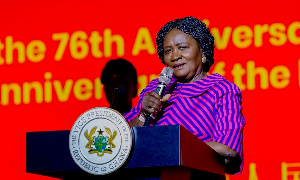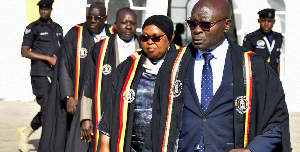The Asante Traditional buildings were recently brought in the spotlight, appearing for instance in “Enslaved”, the Samuel Lee Jackson’s documentary series on history of slavery and slave trade. They were also at the centre of the programme organized in Kumasi-Ejisu in May 2021 by the Ghana Museums and Monuments Board (GMMB), Unesco, the French Embassy and the network of French “Grand Sites” on these buildings and their management.
The Asante Traditional Buildings (ATBs), dating back from the 18th and 19th century, describe the old Asante Traditional architectural style buildings often mentioned and documented by early travelers to the Asante Kingdom. The unique features of these buildings are embedded in their style and method of construction (wattle-and-daub and/or mud monolithic techniques, plastering, and originally steep-pitched thatch roof), traditional motifs, and rich colorization of walls and practice of traditional religion.
The elaborate ornamentation or mural designs were used for palaces, homes of wealthy citizens and shrine houses. However, the long war with the British at the turn of the twentieth century resulted in the destruction of most of these buildings. They were rebuilt in sandcrete blocks and corrugated iron. Ironically, some of the remaining ten (10) buildings that have survived till today are shrine houses of some of the powerful deities who have interceded and protected the Asanteman. Today it is part of Ghana’s cultural heritage.
The ten buildings (Abirim, Adako-Jachie, Asawase, Asenemaso, Bodwease, Edwenase, Ejisu-Besease, Kentikrono, Patakro, Saaman) were acquired for preservation as National Monuments in 1964 by the Ghana Museums and Monuments Board and were listed as World Heritage property by the UNESCO’s World Heritage Committee in 1980, under criteria V as “rare surviving examples of a significant traditional architectural style of the influential, powerful and wealthy Asante kingdom”.
Although some works took place from 1998 to 2002 overseen by GMMB and with help of a French laboratory of traditional architecture (CRA-Terre in Grenoble), and restauration happened in Ejisu-Besease in 2014, their world heritage site status seems to have had little effect on their development as renowned touristic sites and they still remain out of the main touristic tours that are organized in Ghana. More tourists are visiting Forts and Castles or even Lake Bosomtwe, located 30 minutes drive from the ATBs, than this world heritage site, in spite of their uniqueness in West-Africa.
The touristic potential of these buildings is however immense, both for local and foreign visitors, as they present genuine and peculiar cultural and architectural features. They offer the visitor the possibility to immerse in a concentrate of Asante culture through the decorations, the stories that are told, and through the ceremonies and festivals that are still regularly celebrated around them. They fit an environment made of many remains of traditional architecture in villages, though threatened by growing urbanization, lack of maintenance or unjustified discredit for traditional architecture and beliefs systems.
Renovation works are about to start at the building in Edwenase through a joint project between the John Kufuor Foundation and the French Embassy in Accra with the support of the local community.
Let’s hope that it will pave the way to the development of tourism around these sites and that the Ghanaian visitors will discover the architectural and cultural treasures hidden in these red clay walls.
This world heritage sites are a jewel to cherish and a potential source of income through tourism for all those concerned: local communities, traditional and local authorities, state and a source of pride for all Ghanaians.
Regional News of Friday, 21 May 2021
Source: Angela Akua Asante













